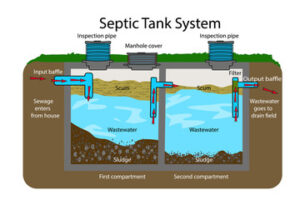Plumbing Repair
A plumber works on piping systems for water, hot water, and sewage. They also install, repair and maintain fixtures such as toilets, bathtubs and showers.
Plumbing professionals like Plumbers In The Woodlands are most often seen repairing burst pipes or fixing a toilet that won’t flush, but they also work in new construction and commercial settings, consulting blueprints and building codes to plan pipe layouts and install plumbing appliances. They must have good problem-solving skills to assess situations and determine the best course of action.

Plumbing is an essential service that provides clean water for use in washing, cooking, and drinking. It also removes waste and sewage, keeping the environment safe and hygienic. Plumbers install, inspect, and repair these systems to ensure they are working properly. They may work on residential or commercial properties and have a wide range of skills, depending on the type of plumbing needed.
When installing new plumbing, plumbers follow a strict set of standards to ensure the safety and quality of the system. This includes using proper materials, following building codes and regulations, and ensuring all fixtures are connected correctly. Additionally, plumbers often install backflow preventers to stop contaminated water from entering the home or business.
For new construction, plumbers can install plumbing for whole-home or individual room installations. This includes toilets, bathtubs, showers, sinks, faucets, water heaters, and more. They can also help with kitchen and bathroom remodels by relocating or replacing existing pipes and fixtures.
Some plumbing tasks require specialized tools. For example, if a job requires the removal of a large section of pipe, a plumber may need to use a hydraulic cutting tool. These tools can be expensive, but they are designed to make the job easier and more efficient. Plumbers also use a variety of other tools, including hand and power tools, wrenches, screwdrivers, pliers, soldering torches, pipe cutters, and more.
There are three main types of plumbing lines: water supply, drainage, and venting. Plumbers can install all three of these for a new home or business. The first step in the installation process is laying out the pipes, which involves measuring the distances between the different fixtures and marking them on the walls and floors. Once the pipes have been laid out, plumbers can install them by connecting them with fittings.
The next step is to connect the drainage line. This involves installing a drain line from the home to the sewer main, as well as a clean-out fitting that allows for easy access to the sewer line in case of a blockage. Plumbers can then connect the venting line to the roof and test the entire system.
Plumbing Repair
A plumbing system is vital for a home or business to function correctly, providing clean water and taking away waste water. If this system is damaged, it can cause health and safety issues. Plumbers install, repair and maintain these systems. Their responsibilities include reading blueprints to plan pipe installations, testing water pressure, locating leaks and unblocking drains. They also advise customers on ways to conserve water and make their plumbing more efficient.
While many plumbing jobs are small, others are complex and require extensive knowledge of hydraulic systems. For example, a plumber may need to set up an entire new sewage system for a building or repair large water lines. They may also need to cut through walls, floors and ceilings to access pipes. Plumbing technicians use a wide variety of tools, including wrenches, pipe cutters, soldering equipment and power tools. They must also follow strict safety protocols when working with hazardous materials or in confined spaces.
Ideally, plumbing repairs should be carried out as soon as a problem is identified. This will prevent further damage, minimize inconvenience and reduce costs. For instance, a leaking faucet can lead to water wastage and increased utility bills. It’s important to hire a professional plumber who can provide you with fast, reliable service.
Plumbing companies should communicate with their clients well. This includes giving clients a window of time when they can expect the plumber to arrive and explaining what work will be done. They should also provide clear pricing and an estimate of how long the work will take. Finally, the plumber should explain any warranties or guarantees on their work.
A plumber can help you save money on your energy bill by installing low-flow toilets, showerheads and dishwashers. These appliances are designed to use less water and energy, while still maintaining functionality. They can also help you qualify for rebates and tax credits. In addition, they can advise you on how to maintain your plumbing system to avoid costly repairs in the future. By following these tips, you can ensure that your plumbing is functioning properly and efficiently.
Plumbing Maintenance
A plumbing system is an integral part of a home or business that keeps fresh water flowing in and waste water out. Many people only think of their plumbing when something goes wrong, but with regular maintenance from a professional plumber, you can avoid costly repairs and keep your system running efficiently.
Plumbing maintenance services include cleaning drains, identifying and fixing leaks, examining water pressure, and more. A plumber can also assess your current water usage to recommend ways to conserve, which will save you money on your energy bills.
Leaks are a common problem that can cause significant damage if left unattended. A plumber can inspect your plumbing for leaks and fix them promptly to prevent water damage and expensive repair bills.
Clogged drains are another common issue that can be prevented with regular cleaning and the use of preventative devices, such as drain screens and strainers. These items can catch hair, food particles, and other debris before it enters the pipes, preventing blockages and improving water flow. A plumber can also examine your home’s landscaping to ensure that trees and shrubs are not overgrowing or blocking pipes.
The adage “an ounce of prevention is worth a pound of cure” is especially true when it comes to plumbing. Waiting until a plumbing disaster strikes can be extremely costly and stressful, but with regular inspections and maintenance from a qualified plumber, you can avoid major problems and keep your plumbing system in good condition.
A well-maintained plumbing system can add value to a property, making it more attractive to potential buyers or tenants. In addition, a well-functioning plumbing system can improve the health and safety of the building’s occupants. A malfunctioning plumbing system can lead to flooding, sewage backups, mold growth, and more. With regular maintenance from a plumber, you can avoid these problems and protect your investment.
A plumbing system is often considered to be less complex than electrical and mechanical systems, but it plays a critical role in ensuring that a building functions properly. A professional plumber can perform regular maintenance to detect and address issues before they become major problems that affect the safety and functionality of a building.
Plumbing Sales
As a plumber, you can sell a variety of products and services. This may include new or replacement parts, water heaters, toilets, faucets, drains, shower heads, and more. You can also offer maintenance contracts to keep plumbing systems running smoothly. These agreements can be a great way to generate recurring revenue while creating trust with clients.
To increase plumbing sales, your team should have access to the right tools. Using a customer relationship management (CRM) software solution will help you create a sales pipeline and manage your entire plumbing business. This tool enables you to track each potential customer from their initial awareness of your brand through scheduling appointments, reviewing scopes of work, providing service estimates, and finally closing the sale. Having full visibility into your pipeline enables you to predict future revenues and identify areas where your plumbing sales skills need improvement.
In addition to boosting your overall profits, a CRM can also improve your job-to-job consistency by making it easier for your staff to send the right technician to each appointment. You can assign certain skills to particular technicians and use a tech scorecard to identify who is best at communicating with customers, for example. This will help you close more sales, and even create a tiering system to motivate top performers.
Educating the customer is another important aspect of plumbing sales. Many homeowners don’t have plumbing knowledge, so it’s important that you communicate clearly and make them feel at ease with your expertise. This can be done by explaining what the problem is, how long it will take to repair, and any additional costs for materials or time spent. It’s also helpful to provide fliers of other services you offer, or post resources on your website.
Lastly, don’t try to sell too much during each visit. While it’s a natural instinct to recommend add-ons, this can turn some people off and damage the trust that you’ve worked hard to build with them. It’s also important to respect the customer’s budget and not oversell. Ensure that your pricing is accurate by working backward from the hourly rate of a plumber at your company, then adding in the cost of insurance, taxes, and overhead.








